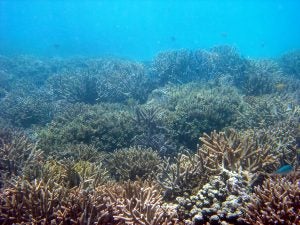
A healthy coral reef
So, why would NASA spend $15M (USD) on a science investigation to address a fundamental question about reef ecosystem science? Glad you asked…
Coral reefs provide a number of ecosystem goods and services, including:
- Shoreline protection
- Economically important fish and shellfish species
- Food for subsistence economies
- Barriers that provide safe passage for shipping
- Biological storehouse for the biotechnology industry
- Ecological reserve of genetic complexity
- Raw materials for medicines
- Support for traditional cultures
- Recreational resource, including a multibillion dollar global tourism industry
It’s been estimated that, worldwide, coral reefs provide $400B (USD) of ecosystem goods and services each year, which is an impressive number considering they constitute 1% of Earth’s surface.
Reefs are also among the first ecosystems to respond critically, dramatically and globally to the combined impacts of local environmental degradation and global climate change. As a result, there is great concern about the current state of reefs, as well as their future.
“Over recent decades, 33–50% of coral reefs have been largely or completely degraded by a combination of local factors and global climate change. Reefs in many regions have lost half or more of their live corals. Additional extensive degradation will inevitably occur over the next two decades as temperatures continue to rise.” – International Society for Reef Studies Consensus Statement, October 2015
What about bleaching?
News of coral bleaching has appeared in the news with increasing frequency, leading many to wonder if CORAL will be studying this particular coral stress response.
While CORAL will be surveying portions of the world’s reefs, including the Great Barrier Reef (where bleaching has been recently observed), it’s unlikely that a CORAL campaign will coincide with an active bleaching event. Rather, CORAL will observe the aftermath.
Specifically, CORAL will observe benthic community structure, which reflects the cumulative, convolved, long-term effects of multiple stressors (e.g., thermal) and other forcing factors (e.g., wave energy). The recent bleaching no doubt will influence the coral:algae:sand ratios that CORAL observes — the question is how much, relative to other factors?
Here are some additional facts about coral bleaching that may help you understand this phenomena:
- Bleaching is a common stress response in corals and has been observed in situations of cold temperatures, low salinities and — most famously — high temperatures, among other stressors.
- Some bleaching occurs naturally in the summertime on a near-annual basis in many locales (e.g., Bermuda, Hawaii).
- Mass bleaching does not occur annually, but during extended periods of region-scale anomalous sea surface temperatures, such as during El Niño in some regions (e.g., Hawaii, Great Barrier Reef) and La Niña in others (e.g., Palau).
- Bleaching does not always kill the coral. If the stress conditions are short-lived (the duration appears to be species-dependent), a bleached coral can be recolonized by zooxanthellae once conditions become more favorable.
- Mass bleaching and mass coral moratlity is not uniform (e.g., some areas of Hawaii bleached last year, and some did not; corals in some areas experienced significant mortality, while corals in other areas recovered from bleaching).
All of this points to the importance of large-scale reef ecosystem surveys, like CORAL, to determine the impacts of localized vs. large-scale and short vs long term bleaching events.

